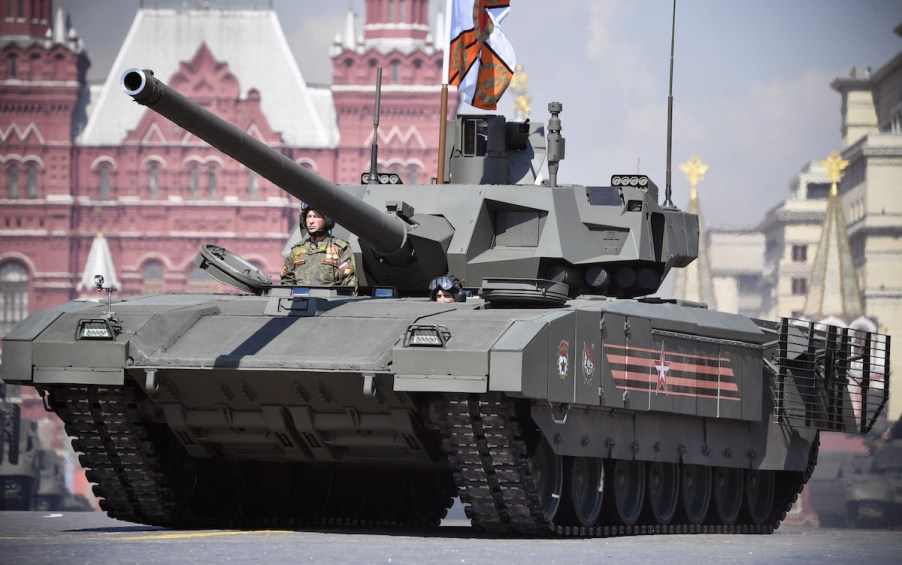
Russia’s T-14 Armata Tank Costs Just Under $4 Million
The news abounds with images of Russia’s invasion of Ukraine. We’ve seen several military trucks on the move, but Russia has other armored vehicles that are just as impressive, including the T-14 Armata. What does this Russian tank offer, and how does it compare to American tanks?
How advanced is Russia’s T-14 Armata tank?

Some Russian tanks from the 1940s to 1960s boasted the best advancements of the day. Top speeds ranged from about 31 to 34 mph. And their gun turrets were 85 to 115mm in diameter.
Today, the newest tank in Russia’s arsenal is the T-14 Armata. This 48-ton beast began as a concept from the Russian Ministry of Defense to replace the “Object 195” program in 2010.
According to 1945, plans show a 125mm cannon with autoloader capabilities to shoot laser-guided missiles up to 7.4 miles. The tank has a forward section protecting the commander, driver, and gunner.
Soldiers can control the turret remotely. Some cameras show a 360-degree viewing area while another camera tops the turret, giving the commander a good field of vision.
The T-14 Armata also has explosives-reactive armor technology that keeps the occupants insulated from direct hits, similar to the ballistic protective armor on American military vehicles. In the center of the T-14 Armata is a compartment that contains the autoloader and ammo storage.
The top speed is about 55 mph, making it one of the fastest available. Russia has about 20 of these tanks in active service.
What’s keeping Russia from mass-producing it?
Given its advanced features, one has to wonder: Why isn’t the T-14 Armata being mass-produced? Russia originally planned to have about 2,300 units made by 2025. But since then, the government scaled the number back to 100 experimental tanks instead.
However, they haven’t met that goal yet. So, what’s preventing Russia from building a large number? This tank costs just shy of $4 million. Producing 100 would be costly, but making 2,300 T-14 Armatas would essentially break the bank.
The 20 in service were delivered to Russia’s military for testing. However, that phase is set to end this year, and serial production is expected to begin then. But with Moscow not having much cash to spend, will the plan come to fruition?
How do other Russian tanks compare to the Armata?
The T-90A model, produced in 1992, is still in service, with 350 active tanks, while 200 sit in reserve. This Russian tank also has a 125mm smoothbore cannon. In addition, Russia’s T-80U tank is the advanced version of the T-80, which came out in 1985.
It offers a 9M119 Refleks anti-tank guided missile system that can fire from its 125mm cannon. There are 450 active units today, with 3,000 sitting in reserve. Russia also has T-72 tanks, some of which were upgraded to the T-72B3 line. However, none can hold a candle to the T-14 Armata.
According to Business Insider, the T-14 might never get to see mass production because of the high cost. That’s interesting because the Armata is the biggest competitor to the M1A2 Abrams, the United States’ most powerful tank. The Abrams sports depleted Uranium armor and a 2.4-mile missile range — five miles shorter than the Armata’s range.
Russia has a powerful weapon on its hands in the T-14 Armata. But without the cash to fund it, the country might not use the tank to its fullest potential.


